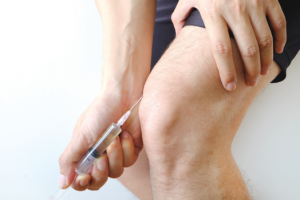
Seasontime / shutterstock.com
A two-year study among patients with knee osteoarthritis (OA) showed that steroid injections for knee pain were no more effective than saline injections and actually reduced cartilage volume more than placebo. The study, conducted at Tufts Medical Center in Boston, looked at progression of cartilage loss and change in knee pain after treatment with placebo or intra-articular injection of 40 mg triamcinolone acetonide every three months for two years. Results were published in JAMA.1
Background
Knee OA is a widespread condition that affects millions of mostly older people and is a leading cause of disability, according to the JAMA article. For years, doctors have been using corticosteroids to temporarily treat pain resulting from knee OA, with debatable success.
“Osteoarthritis is a very common disease, and there isn’t any treatment that’s really been shown to be effective over the long term,” lead study author Timothy E. McAlindon, MD, MPH, chief of rheumatology at Tufts Medical Center, tells The Rheumatologist. “In particular, we don’t have any treatments that are generally believed to be disease modified.”
Pain in the knee is caused by inflammation that can happen when protective cartilage in the joints wears down and bones rub together. Patients with the condition often have difficulty with weight-bearing physical movement, such as standing up, walking, running or various forms of exercise.

Dr. McAlindon
Rheumatologists have a toolbox of treatments for knee joint pain, such as physical therapy, orthotics, topical medication, simple analgesics and even surgery, if deemed suitable. Yet a subset of patients return regularly every three months to have their knees injected with steroids because they have no other suitable treatment choice, Dr. McAlindon says.
Steroids also may be used for patients who have reflux or peptic ulcer or kidney disease because anti-inflammatory medicine is contraindicated. In cases like these, rheumatologists may resort to giving repeated steroid injections, Dr. McAlindon says.
No doubt, patients have benefited from short-term steroid injections to treat flare-up pain that lasts two to four weeks, Dr. McAlindon says. However, historically there has been concern about potential damage to joints, based partly on animal studies that suggested steroids can damage healthy cartilage, according to Dr. McAlindon.
On the other hand, inflammation exists in osteoarthritic joints, notes Dr. McAlindon. “Of course, steroids are potent anti-inflammatory agents, and more recent animal studies suggest that steroids may actually slow down disease progression.”
Inflammation is a common ailment among patients with progressive knee OA. Corticosteroids injected into the joint area can reduce cartilage damage associated with synovitis—inflammation of the membrane that lines the joints—but carry a possibility of adverse effects on cartilage periarticular bone, according to the JAMA article.
Recognizing that there is inflammation in osteoarthritic joints and that the inflammation may damage and cause progression, along with the knowledge that steroids can suppress inflammation, researchers hypothesized that corticosteroids may have disease-modifying effects, notes Dr. McAlindon.
The Study
Enrollment began in 2013 at Tufts Medical Center and the study was completed by Jan. 1, 2015. Recruited patients had an average age of 58, met ACR criteria for symptomatic knee OA and were graded 2 or 3 on the Kellgren-Lawrence scale.
The double-blind, randomized trial involved 140 patients who were given either triamcinolone or saline intra-articular injections every 12 weeks over two years. Synovial fluid was aspirated before injection if present, according to Dr. McAlindon.
During study visits, patients underwent examinations of the treated knee and monitoring of physical function, blood pressure, pain, medication and adverse events. Ultrasound was used to determine degree of inflammation, and magnetic resonance imaging scans conducted at baseline, 12 and 24 months measured quantitative cartilage volume.
Two primary outcomes were change in knee cartilage volume in the index compartment—measured by thickness—and change in pain. The latter was assessed with WOMAC pain subscale patient questionnaires.
Dr. McAlindon says this study is only the second one to measure long-term use, and it is the first to use MRIs to quantitatively measure cartilage and soft-tissue structures. Unlike radiography, MRIs allow direct visualization of those structures and cartilage and is much more precise than X-rays.
“Radiography does not image cartilage directly and is insensitive to change, so it may not have detected the small changes in cartilage loss measured on the MRIs in this study,” states the article.
Study results revealed that patients treated with triamcinolone injections had a greater rate of cartilage loss in the index compartment compared with patients given placebo (-0.21 vs. -0.10 mm, respectively). Knee pain decreased somewhat, but not significantly more in one group than the other (-1.2 units in the triamcinolone vs. -1.9 in the saline group).
“Everybody loses some cartilage volume with age,” Dr. McAlindon says, commenting on the results. “That’s to be expected. Of course, the hope of this study was that this may actually be beneficial, but in fact we found no difference between the groups for all the outcomes except cartilage volume, where, in fact, the loss was increased.”
The authors concluded that the findings do not support “this treatment for patients with symptomatic knee osteoarthritis.”
Because there is potential for the study findings to cause concern, Dr. McAlindon says that it’s important to put them in context.
What This Means
“The magnitude of loss was not all that great,” says Dr. McAlindon. “Clearly, in this particular study, the two years didn’t translate into a clinically important difference between the two groups.”
The research by no means suggests that rheumatologists should altogether avoid steroid injections to treat knee pain of patients with OA, he says. In some cases, the injections can help break a cycle and deal with an acute escalation of pain.
In other words, rheumatologists considering treatment options for osteoarthritic knee pain should not interpret the study results as a reason to ban steroids, notes Dr. McAlindon. “I wouldn’t want [these results] to discourage people from having the occasional steroid injections, because those are useful for short-term pain,” he says.
However, the findings do indicate that repeated injections over two years show no real long-term benefit in relation to a patient’s pain or the management of OA and structural progression. In addition, although the greater cartilage loss observed in the treatment group was not considered clinically significant, it could make a difference in a patient’s quality of life over a longer stretch of time, Dr. McAlindon says.
“Losing cartilage faster over the years makes the need for knee joint replacement more likely,” he says.
Discussion of study limitations in the article points out that any transient benefit on pain ending within the three-month period between each injection could have been missed, because pain was not measured within the four-week period after each injection.
Catherine Kolonko is a medical writer based in Oregon.
Reference
- McAlindon TE, LaValley MP, Harvey WF, et al. Effect of intra-articular triamcinolone vs saline on knee cartilage volume and pain in patients with knee osteoarthritis. A randomized clinical trial. JAMA. 2017 May 16;317(19):1967–1975.

